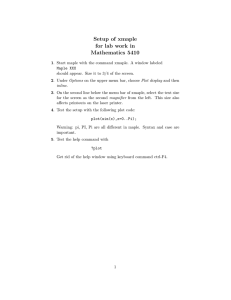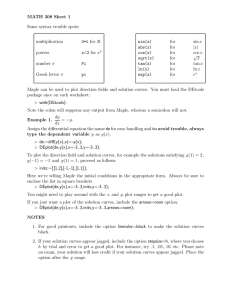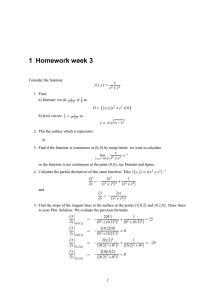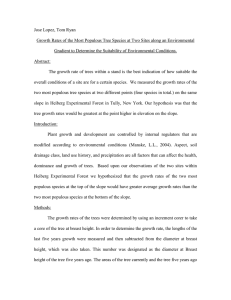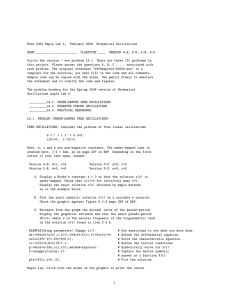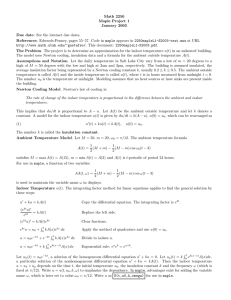MATH 308 Sheet 1 Some syntax trouble spots: multiplication for 3t
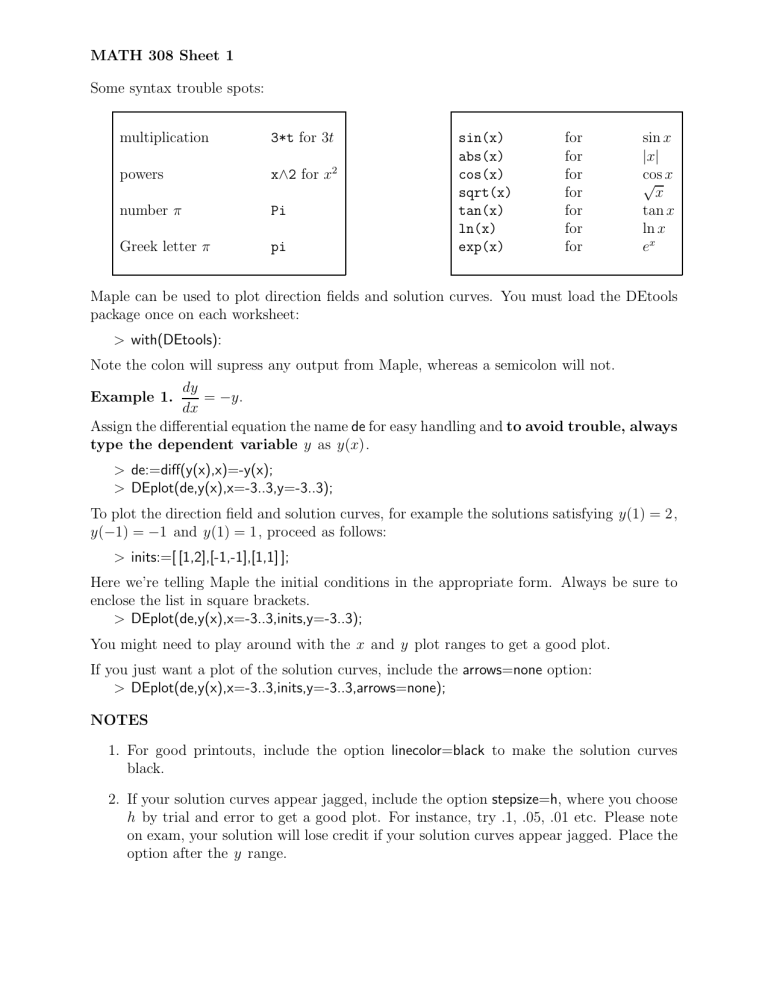
MATH 308 Sheet 1
Some syntax trouble spots: multiplication powers number π
Greek letter π
3*t
Pi pi for 3 x ∧ 2 for x t
2 sin(x) abs(x) cos(x) sqrt(x) tan(x) ln(x) exp(x) for for for for for for for
Maple can be used to plot direction fields and solution curves. You must load the DEtools package once on each worksheet:
> with(DEtools):
Note the colon will supress any output from Maple, whereas a semicolon will not.
dy
Example 1.
dx
= − y.
Assign the differential equation the name de for easy handling and to avoid trouble, always type the dependent variable y as y ( x ).
> de:=diff(y(x),x)=-y(x);
> DEplot(de,y(x),x=-3..3,y=-3..3);
To plot the direction field and solution curves, for example the solutions satisfying y (1) = 2, y ( − 1) = − 1 and y (1) = 1, proceed as follows:
> inits:=[ [1,2],[-1,-1],[1,1] ];
Here we’re telling Maple the initial conditions in the appropriate form. Always be sure to enclose the list in square brackets.
> DEplot(de,y(x),x=-3..3,inits,y=-3..3);
You might need to play around with the x and y plot ranges to get a good plot.
If you just want a plot of the solution curves, include the arrows=none option:
> DEplot(de,y(x),x=-3..3,inits,y=-3..3,arrows=none);
NOTES
1. For good printouts, include the option linecolor=black to make the solution curves black.
2. If your solution curves appear jagged, include the option stepsize=h , where you choose h by trial and error to get a good plot. For instance, try .1, .05, .01 etc. Please note on exam, your solution will lose credit if your solution curves appear jagged. Place the option after the y range.
sin x
| x | cos x
√ x tan x ln x e x
3. To resize Maple’s plots, click on the graph and drag the corners with the mouse.
4. Use the initial conditions to help you pick the x and y plot ranges. For instance, if y ( − 3) = − 1, use x=-6..0, y=-4..2
as a starting point and play around from there if necessary.
5. The command restart: will clear all values of variables. It’s a good thing to try when things go wrong.
6. To type text in a Maple worksheet, hit the button with the T on it. To restore the
Maple prompt, hit the button with the [ > on it.
dy
Example 2.
dx solution satisfying
= sin( y ) .
Plot the direction field using Maple. What happens to the
1.
y (0) = 1 as x → ∞ .
2.
y (2) = − 2 as x → ∞ .
3.
y (0) = 7 as x → ∞ .
Example 3.
The population p ( t ) in thousands of a certain species satisfies the differential dp equation = 3 p dt following questions.
− 2 p 2 . Use Maple to sketch the direction field and use it to answer the
1. If the initial population is 2000 individuals (i.e., p (0) = 2), what is the limiting population?
2. If the initial population is 500 individuals, what is the limiting population?
3. Can a population of 3000 individuals ever decline to 500 individuals?
Example 4.
For a bar magnet, the magnetic field lines satisfy the differential equation dy
=
3 xy
. Plot the direction field. Does it remind you of anything?
dx 2 x 2 − y 2
Homework
Text: page 22/4, 7, 10 Use Maple on all these.
Lab Book: page 25/1b, 3c, 8, 10b
